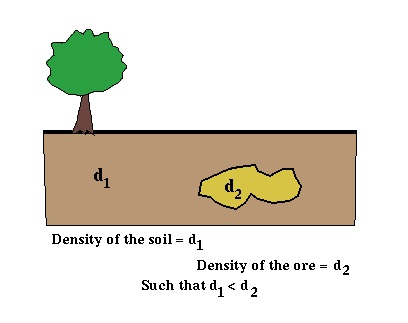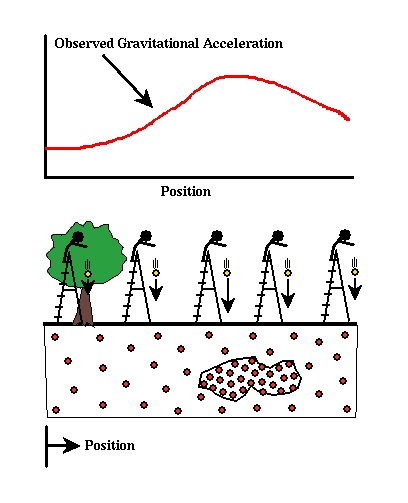How is the Gravitational Acceleration, g, Related to Geology?
Density is defined as mass per unit volume. For example, if we were to calculate the density of a room filled with people, the density would be given by the average number of people per unit space (e.g., per cubic foot) and would have the units of people per cubic foot. The higher the number, the more closely spaced are the people. Thus, we would say the room is more densely packed with people. The units typically used to describe density of substances are grams per centimeter cubed (gm/cm^3); mass per unit volume. In relating our room analogy to substances, we can use the point mass described earlier as we did the number of people.
Consider a simple geologic example of an ore body buried in soil. We would expect the density of the ore body, d2, to be greater than the density of the surrounding soil, d1.

The density of the material can be thought of as a number that quantifies the number of point masses needed to represent the material per unit volume of the material just like the number of people per cubic foot in the example given above described how crowded a particular room was. Thus, to represent a high-density ore body, we need more point masses per unit volume than we would for the lower density soil*.

Now, let's qualitatively describe the gravitational acceleration experienced by a ball as it is dropped from a ladder. This acceleration can be calculated by measuring the time rate of change of the speed of the ball as it falls. The size of the acceleration the ball undergoes will be proportional to the number of close point masses that are directly below it. We're concerned with the close point masses because the magnitude of the gravitational acceleration varies as one over the distance between the ball and the point mass squared. The more close point masses there are directly below the ball, the larger its acceleration will be.

We could, therefore, drop the ball from a number of different locations, and, because the number of point masses below the ball varies with the location at which it is dropped, map out differences in the size of the gravitational acceleration experienced by the ball caused by variations in the underlying geology. A plot of the gravitational acceleration versus location is commonly referred to as a gravity profile.

This simple thought experiment forms the physical basis on which gravity surveying rests.
*In this discussion we assume that all of the point masses have the same mass.
Gravity
- Overviewpg 12
- -Temporal Based Variations-
- Instrument Driftpg 13
- Tidespg 14
- A Correction Strategy for Instrument Drift and Tidespg 15
- Tidal and Drift Corrections: A Field Procedurepg 16
- Tidal and Drift Corrections: Data Reductionpg 17
- -Spatial Based Variations-
- Latitude Dependent Changes in Gravitational Accelerationpg 18
- Correcting for Latitude Dependent Changespg 19
- Vari. in Gravitational Acceleration Due to Changes in Elevationpg 20
- Accounting for Elevation Vari.: The Free-Air Correctionpg 21
- Variations in Gravity Due to Excess Masspg 22
- Correcting for Excess Mass: The Bouguer Slab Correctionpg 23
- Vari. in Gravity Due to Nearby Topographypg 24
- Terrain Correctionspg 25
- Summary of Gravity Typespg 26